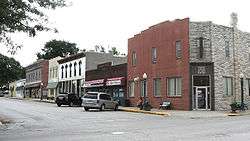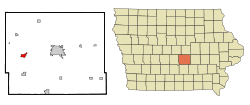Colfax, Iowa
Colfax is a city in Jasper County, Iowa, United States. Colfax is located approximately 24 miles east of Des Moines. The town was founded in 1866, and was named after Schuyler Colfax, vice president under Ulysses S. Grant. The population was 2,093 at the 2010 census.[5] Newton is the county seat; both were named after Revolutionary War soldiers.[6]
Colfax, Iowa | |
|---|---|
 Downtown Colfax, Iowa | |
 Location of Colfax, Iowa | |
| Coordinates: 41°40′33″N 93°14′40″W | |
| Country | USA |
| State | |
| County | Jasper |
| Incorporated | August 10, 1875[1] |
| Area | |
| • Total | 2.59 sq mi (6.70 km2) |
| • Land | 2.36 sq mi (6.11 km2) |
| • Water | 0.23 sq mi (0.59 km2) |
| Elevation | 801 ft (244 m) |
| Population | |
| • Total | 2,093 |
| • Estimate (2019)[4] | 2,064 |
| • Density | 874.58/sq mi (337.70/km2) |
| Time zone | UTC-6 (Central (CST)) |
| • Summer (DST) | UTC-5 (CDT) |
| ZIP code | 50054 |
| Area code(s) | 515 |
| FIPS code | 19-15060 |
| GNIS feature ID | 0455527 |
History
Colfax was laid out in 1866.[7] It is named for Schuyler Colfax.[8]
In its heyday, the city of Colfax had two main industries that drew thousands to the area: the mining of coal, and the use of the mineral springs discovered near the city.
The first large scale coal mine in Jasper County was the Watson No. 1 Mine, 5 miles southeast of town, connected to the Rock Island by a long railroad spur. From 1881 to 1900, the Jasper County Coal and Railway Company operated a number of mines north of Colfax. The Colfax Consolidated Coal Company formed in 1902, bringing the mines of Colfax under a common operator. They opened mine No. 8 in 1905; this was one of the best equipped mines in the state. The coal camp of Severs was run by this company.[9]
United Mine Workers local 56 was organized in Colfax in 1899; by 1907, it had 352 members. Mine wages varied from $2.36 to $2.56 per day.[10] In 1912, the UMW union had two locals based in Colfax, Local 56, with 350 members, and Local 671, with 230 members.[11]
In the process of drilling for coal in 1875, a well containing high mineral content was discovered near Colfax. The city flourished with this new discovery, and over the next four decades, thousands of people visited the town to partake in the healing powers of the fourteen mineral springs there. Nine hotels offering mineral baths and spa treatments opened to house guests, and four bottling companies opened to produce bottled mineral water for the masses. In 1912–1913, the city received funding to build a Carnegie library. The library is still in use today.[12] The booming business of the city's mineral springs industry declined and died out as the Great Depression swept the country.[5]
Geography
According to the United States Census Bureau, the city has a total area of 1.80 square miles (4.66 km2), of which 1.79 square miles (4.64 km2) is land and 0.01 square miles (0.03 km2) is water.[13]
Demographics
| Year | Pop. | ±% |
|---|---|---|
| 1880 | 620 | — |
| 1890 | 957 | +54.4% |
| 1900 | 2,053 | +114.5% |
| 1910 | 2,524 | +22.9% |
| 1920 | 2,504 | −0.8% |
| 1930 | 2,213 | −11.6% |
| 1940 | 2,222 | +0.4% |
| 1950 | 2,279 | +2.6% |
| 1960 | 2,331 | +2.3% |
| 1970 | 2,293 | −1.6% |
| 1980 | 2,234 | −2.6% |
| 1990 | 2,462 | +10.2% |
| 2000 | 2,223 | −9.7% |
| 2010 | 2,093 | −5.8% |
| 2019 | 2,064 | −1.4% |
| Source:"U.S. Census website". United States Census Bureau. Retrieved 2020-03-29. and Iowa Data Center Source: | ||


2010 census
As of the census[3] of 2010, there were 2,093 people, 851 households, and 569 families residing in the city. The population density was 1,169.3 inhabitants per square mile (451.5/km2). There were 927 housing units at an average density of 517.9 per square mile (200.0/km2). The racial makeup of the city was 98.3% White, 0.3% African American, 0.4% Native American, 0.1% Asian, 0.1% from other races, and 0.7% from two or more races. Hispanic or Latino of any race were 0.9% of the population.
There were 851 households of which 32.8% had children under the age of 18 living with them, 49.4% were married couples living together, 12.3% had a female householder with no husband present, 5.2% had a male householder with no wife present, and 33.1% were non-families. 27.7% of all households were made up of individuals and 13.5% had someone living alone who was 65 years of age or older. The average household size was 2.42 and the average family size was 2.95.
The median age in the city was 38.3 years. 25% of residents were under the age of 18; 6.8% were between the ages of 18 and 24; 26.1% were from 25 to 44; 27.1% were from 45 to 64; and 14.8% were 65 years of age or older. The gender makeup of the city was 49.2% male and 50.8% female.
2000 census
As of the census[15] of 2000, there were 2,223 people, 837 households, and 585 families residing in the city. The population density was 1,632.4 people per square mile (631.1/km2). There were 908 housing units at an average density of 666.8 per square mile (257.8/km2). The racial makeup of the city was 98.25% White, 0.49% African American, 0.22% Native American, 0.18% Asian, and 0.85% from two or more races. Hispanic or Latino of any race were 0.72% of the population.
There were 837 households out of which 35.1% had children under the age of 18 living with them, 57.1% were married couples living together, 8.6% had a female householder with no husband present, and 30.0% were non-families. 26.5% of all households were made up of individuals and 11.0% had someone living alone who was 65 years of age or older. The average household size was 2.56 and the average family size was 3.12.
Age spread: 29.2% under the age of 18, 8.5% from 18 to 24, 28.7% from 25 to 44, 22.0% from 45 to 64, and 11.6% who were 65 years of age or older. The median age was 35 years. For every 100 females, there were 102.5 males. For every 100 females age 18 and over, there were 96.8 males.
The median income for a household in the city was $41,006, and the median income for a family was $48,300. Males had a median income of $35,326 versus $22,150 for females. The per capita income for the city was $17,662. About 5.2% of families and 6.7% of the population were below the poverty line, including 10.0% of those under age 18 and 4.2% of those age 65 or over.
Education
Colfax-Mingo Community School District operates area public schools.[16] The Colfax and Mingo school districts consolidated on July 1, 1985.[17]
Notable people
- James Norman Hall (1887–1951) author best known for the novel Mutiny on the Bounty[18]
- Herschel F. Briles, United States Army soldier and recipient of the Medal of Honor
- James B. Weaver (1833-1912), 1892 Presidential candidate of the People's Party and mayor of Colfax from 1901–1903.[19]
Footnotes
- "Colfax-Iowa". City-Data. Retrieved 2011-06-01.
- "2019 U.S. Gazetteer Files". United States Census Bureau. Retrieved July 17, 2020.
- "U.S. Census website". United States Census Bureau. Retrieved 2012-05-11.
- "Population and Housing Unit Estimates". United States Census Bureau. May 24, 2020. Retrieved May 27, 2020.
- Colfax Main Street (2009-05-18). "About". Colfax Main Street. Archived from the original on 2013-09-01. Retrieved 2013-07-30.
- acooley@joplinglobe.com, Ariel Cooley. "Jasper, Newton paired together because of story from American Revolution". Joplin Globe. Retrieved 2019-10-24.
- The History of Jasper County, Iowa, Containing a History of the County, Its Cities, Towns, &c. Western Historical. 1878. p. 497.
- Clyde, Jefferson F. (1918). History of Mitchell and Worth Counties, Iowa, Volume 1. S.J. Clarke Publishing Company. p. 350.
- James H. Lees, History of Coal Mining in Iowa, Chapter III of Annual Report, 1908, Iowa Geological Survey, 1909, 564–565.
- Trade Unions in Iowa, Thirteenth Report of the Bureau of Labor Statistics for the State of Iowa for the period 1906-1907, Des Moines, 1908; page 200.
- Tally Sheet, Proceedings of the 23rd Annual Convention of the United Mine Workers of America Jan. 16 – Feb. 2, 1912, Indianapolis; Volume 2, pages 180A-182A.
- "Photos: Carnegie Libraries". Iowa Backroads. Retrieved 2013-07-30.
- "US Gazetteer files 2010". United States Census Bureau. Archived from the original on 2012-07-02. Retrieved 2012-05-11.
- "Census of Population and Housing". Census.gov. Retrieved June 4, 2015.
- "U.S. Census website". United States Census Bureau. Retrieved 2008-01-31.
- "Colfax-Mingo Archived 2018-04-27 at the Wayback Machine." Iowa Department of Education. Retrieved on January 28, 2019.
- "REORGANIZATION & DISSOLUTION ACTIONS SINCE 1965-66 Archived 2019-02-09 at the Wayback Machine." Iowa Department of Education. Retrieved on July 20, 2018.
- Roulston, Robert (November 1978). "James Norman Hall Past, Present, and Future". Books at Iowa 29. The University of Iowa. Retrieved February 12, 2011.
- David Hudson, Marvin Bergman, and Loren Horton, The Biographical Dictionary of Iowa. Iowa City: University of Iowa Press, 2009; pg. 545.